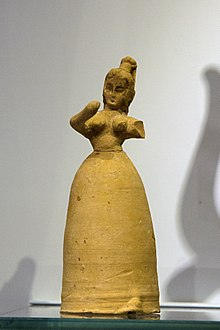
Back خزافة مينوسية Arabic Мінойская кераміка Byelorussian Минойска керамика Bulgarian Ceràmica minoica Catalan Minoische Keramik German Cerámica minoica Spanish Ceramica minoica Italian Минойская керамика Russian Minojska keramika Slovenian Минојска грнчарија Serbian


The Minoan civilization produced a wide variety of richly decorated Minoan pottery. Its restless sequence of quirky maturing artistic styles reveals something of Minoan patrons' pleasure in novelty while they assist archaeologists in assigning relative dates to the strata of their sites. Pots that contained oils and ointments, exported from 18th century BC Crete, have been found at sites through the Aegean islands and mainland Greece, in Cyprus, along coastal Syria and in Egypt, showing the wide trading contacts of the Minoans.
The pottery includes vases, figurines, models of buildings, and burial urns called larnakes. Several pottery shapes, especially the rhyton cup, were also produced in soft stones such as steatite, but there was almost no overlap with metal vessels. The finest achievements came in the Middle Minoan period, with the palace pottery called Kamares ware, and the Late Minoan all-over patterned "Marine Style" and "Floral Style". These were widely exported around the Aegean civilizations and sometimes beyond, and are the high points of the Minoan pottery tradition.
The most comprehensive collection is in the Heraklion Archaeological Museum on Crete.
© MMXXIII Rich X Search. We shall prevail. All rights reserved. Rich X Search